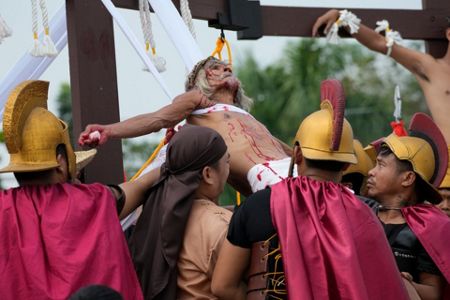SAN PEDRO CUTUD, Philippines (AP) — Eight Filipinos were nailed to crosses to reenact Jesus Christ’s suffering in a bloody Good Friday tradition, including a carpenter, who was crucified for the 34th time with a prayer for Russia’s invasion of Ukraine to end because it has made poor people like him more desperate.
The real-life crucifixions in the farming village of San Pedro Cutud in Pampanga province north of Manila resumed after a three-year pause due to the coronavirus pandemic. About a dozen villagers registered but only eight people showed up, including 62-year-old carpenter and sign painter Ruben Enaje, who screamed as he was nailed to a wooden cross with a large crowd watching in the scorching summer heat.
In a news conference shortly after his crucifixion, Enaje said he prayed for the eradication of the COVID-19 virus and the end of Russia’s invasion of Ukraine, which has contributed to gas and food prices soaring worldwide.
"It's just these two countries involved in that war, Russia and Ukraine, but all of us are being affected by the higher oil prices even if we’re not involved in that war,” said Enaje.
Ahead of the crucifixions, Enaje told The Associated Press that the steep increases in oil and food prices after Russia invaded Ukraine made it harder for him to stretch his meager income from carpentry and sign making.
Thousands of people, including foreign tourists, came to watch the annual religious spectacle in San Pedro Cutud and two other nearby rural villages.
Kitty Ennett, a veterinarian from Ireland, said the crucifixions were “a very religious experience” and they were worth the long trip from her home in the United Kingdom.
“When I was seeing the young man doing the flogging and going up to the cross, it’s very moving to see how much they sacrifice for their faith,” Ennett told The AP. “They really put themselves in the shoes of Jesus.”
Enaje survived nearly unscathed when he fell from a three-story building in 1985, prompting him to undergo the ordeal as thanksgiving for what he considered a miracle. He extended the ritual after loved ones recovered from serious illnesses, one after another, turning him into a village celebrity as the “Christ” in the Lenten reenactment of the Way of the Cross.
Ahead of their crucifixion on a dusty hill, Enaje and the other devotees, wearing thorny crowns of twigs, carried heavy wooden crosses on their backs for more than a kilometer (more than half a mile) in the brutal heat. Village actors dressed as Roman centurions later hammered 4-inch (10-centimeter) stainless steel nails through his palms and feet, then set him aloft on a cross under the sun for about 10 minutes.
Other penitents walked barefoot through village streets and beat their bare backs with sharp bamboo sticks and pieces of wood. Some participants in the past opened cuts in the penitents’ backs using broken glass to ensure the ritual was sufficiently bloody.
The gruesome spectacle reflects the Philippines’ unique brand of Catholicism, which merges church traditions with folk superstitions.
Many of the mostly impoverished penitents undergo the ritual to atone for their sins, pray for the sick or for a better life, and give thanks for miracles.
Church leaders in the Philippines have frowned on the crucifixions and self-flagellations, saying Filipinos can show their faith and religious devotion without hurting themselves and by doing charity work instead, such as donating blood.
Robert Reyes, a prominent Catholic priest and human rights activist in the country, said the bloody rites reflect the church’s failure to fully educate many Filipinos on Christian tenets, leaving them on their own to explore personal ways of seeking divine help for all sorts of maladies.
Folk Catholicism has become deeply entrenched in the local religious culture, Reyes said, citing a chaotic annual procession of a black statue of Jesus Christ called the Black Nazarene, which authorities say draws more than a million devotees each January in one of Asia’s largest religious festivals. Many bring towels to be wiped on the wooden statue, believing it has powers to cure ailments and ensure good health and a better life.
“The question is, where were we church people when they started doing this?” Reyes asked, saying the clergy should immerse itself in communities more and talk with villagers. “If we judge them, we’ll just alienate them.”
The decadeslong crucifixion tradition, meanwhile, has put impoverished San Pedro Cutud — one of the more than 500 villages in rice-growing Pampanga province — on the map.
Organizers said more than 15,000 foreign and Filipino tourists and devotees gathered for the cross nailings in Cutud and two other nearby villages. There was a festive air as villagers peddled bottled water, hats, food and religious items, and police and marshals kept order.
“They like this because there is really nothing like this on earth,” said Johnson Gareth, a British tour organizer, who brought 15 tourists from eight countries, including the U.S., Canada and Germany, to witness the crucifixions.
“It’s less gruesome than people think," Gareth told The AP. "They think it’s going to be very macabre or very disgusting but it’s not. It’s done in a very respectful way.” ___
Associated Press journalists Aaron Favila and Cecilia Forbes contributed to this report.
Copyright 2023 The Associated Press. All rights reserved. This material may not be published, broadcast, rewritten or redistributed without permission.











